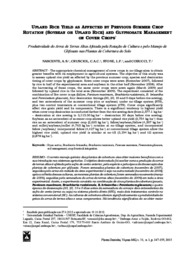Upland rice yield as affected by previous summer crop rotation (soybean or upland rice) and glyphosate management on cover crops.
Upland rice yield as affected by previous summer crop rotation (soybean or upland rice) and glyphosate management on cover crops.
Autoria: NASCENTE, A. S.; CRUSCIOL, A. S.; STONE, L. F.; COBUCCI, T.
Resumo: The appropriate chemical management of cover crops in no-tillage aims to obtain greater benefits with its employment in agricultural systems. The objective of this study was to assess upland rice yield as affected by the previous summer crop, species and desiccation timing of cover crops by glyphosate. Sown cover crops were sown (November 2007), followed by rice in half of the experimental area and soybean in the other half (November 2008). After the harvesting of these crops, the same cover crops were sown again (March 2009) and followed by upland rice in the total area (November 2009). The experiment consisted of the combination of five cover crops (fallow, Panicum maximum, Brachiaria ruziziensis, B. brizantha and Pennisetum glaucum), four desiccation timings (30, 20, 10 and 0 days before rice sowing), and two antecedents of the summer crop (rice or soybean) under no-tillage system (NTS), plus two control treatments at conventional tillage system (CTS). Cover crops significantly affect rice grain yield and its components. There is a significant tendency to highest yield when cover crop desiccation is conducted farther from the rice sowing date (from 2,577.1 kg ha-1 ? desiccation at rice sowing to 3,115.30 kg ha-1 ? desiccation 30 days before rice sowing). Soybean as an antecedent of summer crop allows better upland rice yield (3,754 kg ha-1) than rice as an antecedent of summer crop (2,635 kg ha-1); fallow/soybean/fallow (4,507 kg ha-1) and millet/soybean/millet (4,765 kg ha-1) rotation at no-tillage system, and incorporated fallow /soybean/ incorporated fallow (4,427 kg ha-1) at conventional tillage system allow the highest rice yield; upland rice yield is similar at no-till (3,194 kg ha-1) and till system (2,878 kg ha-1).
Ano de publicação: 2013
Tipo de publicação: Artigo de periódico
Unidade: Embrapa Arroz e Feijão
Palavras-chave: Arroz, Brachiaria brizantha, Brachiaria ruziziensis, Manejo do solo, Oryza sativa, Panicum maximum, Penissetum glaucum, Soja
Observações
1 - Por padrão são exibidas publicações dos últimos 20 anos. Para encontrar publicações mais antigas, configure o filtro ano de publicação, colocando o ano a partir do qual você deseja encontrar publicações. O filtro está na coluna da esquerda na busca acima.
2 - Para ler algumas publicações da Embrapa (apenas as que estão em formato ePub), é necessário ter, no celular ou computador, um desses softwares gratuitos. Sistemas Android: Google Play Livros; IOS: iBooks; Windows e Linux: software Calibre.
Acesse outras publicações
Acesse a Base de Dados da Pesquisa Agropecuária (BDPA) para consultar o acervo completo das bibliotecas da Embrapa.

